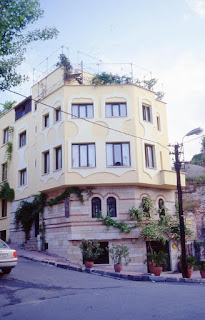This one gives you an idea of the neighbourhood.
And this is what the Empress Zoe Hotel looks like from the street. There is a dome peeking out from the right edge of the picture. That was a haman, a Turkish bath. I didn't visit that one but I did get the experience in another one elsewhere.
After taking the photos there was still no sign of breakfast. Oh well, it was only 0700 on a Sunday and it was a bit unreasonable of me to expect to be served this early, even if I did feel hungry due to the jet lag. So I went back to bed for a nap.
This hotel had two friendly cats, a plump orange one, and a skinnier gray tabby. For sure a spoiled cat, one with its own cushion.
There were lots of cats in the streets and they were not shy of people so I supposed that they were not maltreated.
The best thing about a Turkish breakfast was the warm fresh bread especially the fragrant simit, a Turkish sesame ring. There would be flavourful fruit preserves, not made in a factory but by some local artisan.
All these were consumed in a serene terrace garden, right in the middle of a metropolis. Nothing quite prepares you for the pleasant surprises of travel, being hit by the sensations of a place in its entirety instead of reading about them piecemeal from books, no matter how well illustrated.
Suitably fortified, I set out to visit Topkapı. You may have noticed that there is no dot on the i. This is an opportune time to explain Turkish orthography. Languages in the Turkic family have a vowel harmony rule. Vowels are divided into two classes, the front vowels: eiöü, and the back vowels: aıou. The rule requires that front and back vowels not appear together in a word. The dotless ı is pronounced er so Topkapı rhymes with supper and not coffee. After you have pronounced Turkish words you will appreciate how vowel harmony reduces oral work and makes the spoken language flow better.
Topkapı Sarayı (palace) to give its full name, was the residence of the Ottoman sultans for about 400 years. In 1856, the residence moved to a European style palace Dolmabahçe along the Bosphorus. When the Ottoman empire was consigned to history books in 1921, Topkapı became a museum. Topkapı means cannon gate by the way.
The grounds are vast. It took us 5 minutes to walk from the outer gate to the inner courtyard.
This is the throne room.
There is a lot of mystique surrounding a sultan's palace, because of the harem, which is just the private portion of the palace. I suppose the idea feeds the polygamous fantasies of European cultures. Personally I wouldn't want be a sultan. A palace is still a cage, even for the master; I'd rather have my freedom.
The is the ablution house.
The best part of the tour was after the official guide left us to our own devices and I found a kiosk serving refreshments, overlooking the Sea of Marmara. I sat in the shade, took in the cool breezes and sipped a beer.
The rest of the day's adventures will be in the next post.









No comments:
Post a Comment